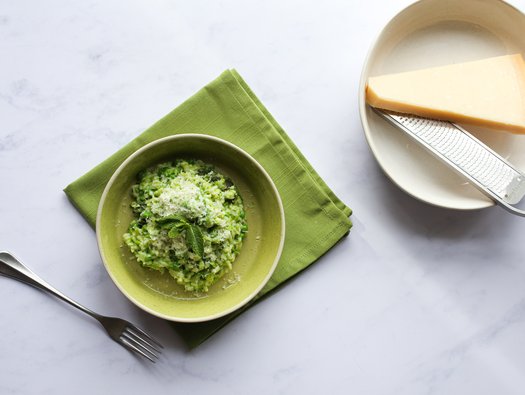Pea and mint risotto

A simple, light and easy to make dish which is low in potassium, phosphate and salt. It is a good choice for anyone reducing their protein intake.

A simple, light and easy to make dish which is low in potassium, phosphate and salt. It is a good choice for anyone reducing their protein intake.
570ml low salt vegetable stock
1 small onion
2 tablespoons olive oil
350g Arborio risotto rice
340g garden peas
25g unsalted butter
30g fresh mint
30g vegetarian Italian style cheese
Freshly ground black pepper
Heat the stock until almost boiling and then simmer over a very low heat. Chop the onion and cook with a little oil on a low heat until soft in a separate saucepan. Add the rice to the onion and mix well for a few seconds to coat the grains with oil. Pour in 1/3 of the stock and simmer until almost all the stock is absorbed.
Keep adding a little stock at a time until the rice is firm and slightly chewy. You may not need all the stock, but the texture should be loose and creamy.
Purée 250g of the peas with half of the fresh mint using an electric or hand blender. Boil the remaining 90g peas in plenty of unsalted water.
Stir the pureed pea and mint mix with butter into the risotto along with the remaining boiled whole peas, the rest of the mint and the grated cheese. Season well with pepper. Divide between four bowls and serve.
The main source of carbohydrate in this dish is the Arborio rice. The carbohydrate value of this dish has been provided for those who have been trained in insulin adjustment.
This recipe is low in potassium, when following the quantities and serving sizes given, so it is suitable if you have been advised to reduce the amount of potassium in your diet.
Although this dish contains vegetarian cheese, which is a high phosphate food, we have only used a small quantity. This helps to keep the overall dish low in phosphate. If you have been prescribed a phosphate binder, ensure you take them with this dish.
This dish contains a moderate amount of protein, with the peas being the main source. It is therefore an ideal meal if you have been advised to reduce your protein intake.
If you are not vegetarian, adding chicken or fish would increase the protein in this dish, making it especially suitable if you are on dialysis or have been advised to follow a higher protein diet.
Use a gluten-free stock.
Use a dairy-free butter and cheese alternative.
We have not added any salt to this recipe. The cheese does contain some salt, but you can choose to leave this out. Using a homemade stock would help reduce the salt content compared to using a ready-made stock. Alternatively, low salt and very low salt stock cubes and stock pots are available to buy in the supermarkets.
Use frozen peas as a cheaper and more convenient option to fresh peas. You could use two teaspoons of dried mint leaves instead of the bunch of fresh mint. If you cook with mint regularly, buying a plant and growing it yourself is a cheaper option.
Allow to cool, refrigerate and eat within one day. When reheating the dish, ensure the centre is piping hot. If freezing, place in a sealed container and when reheating, ensure that the food has been thoroughly defrosted and is piping hot before serving.
If you aren’t vegetarian, you can use parmesan cheese.
By giving us your email address, you're giving us permission to send you the latest news from Kidney Care UK. Further information about how we protect and use your personal data is available in our Privacy policy. If you would like to change the way we communicate with you at any time please email [email protected]. You can unsubscribe at any time by using the link at the bottom of every email we send.